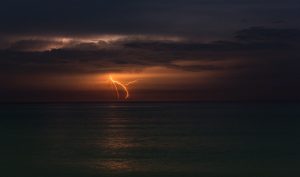 Courtesy of iii.org
Courtesy of iii.org
With 1,800 thunderstorms in progress at any given time on Earth, it’s important to be able to sort out the myths from the facts when it comes to lightning safety. And keep in mind that the best lightning safety plan of all is to take shelter in a house or other structure, or a hard-topped fully enclosed vehicle during a storm: “When thunder roars, go indoors!”
MYTH 1 LIGHTNING NEVER STRIKES THE SAME PLACE TWICE Fact: Lightning often strikes the same place repeatedly, especially if it’s a tall, pointy, isolated object. The Empire State Building was once used as a lightning laboratory, because it’s hit nearly 25 times per year, and has been known to have been hit up to a dozen times during a single storm.
MYTH 2 LIGHTNING ONLY STRIKES THE TALLEST OBJECTS Fact: Lightning is indiscriminate and it can find you anywhere. Lightning hits the ground instead of trees, cars instead of nearby telephone poles, and parking lots instead of buildings.
MYTH 3 IN A THUNDERSTORM, IT’S OK TO GO UNDER A TREE TO STAY DRY Fact: Sheltering under a tree is just about the worst thing you can do. If lightning does hit the tree, there’s the chance that a “ground charge” will spread out from the tree in all directions. Being underneath a tree is the second leading cause of lightning casualties.
MYTH 4 IF YOU DON’T SEE CLOUDS OR RAIN, YOU’RE SAFE Fact: Lightning can often strike more than three miles from the thunderstorm, far outside the rain or even the thunderstorm cloud. “Bolts from the Blue,” though infrequent, can strike 10?15 miles from the thunderstorm. Anvil lightning can strike the ground over 50 miles from the thunderstorm, under extreme conditions.
MYTH 5 A CAR WITH RUBBER TIRES WILL PROTECT YOU FROM LIGHTNING Fact: Most vehicles are safe because the metal roof and sides divert lightning around you. The rubber tires have little to do with protecting you. Keep in mind that convertibles, motorcycles, bikes, open shelled outdoor recreation vehicles, and cars with plastic or fiberglass shells offer no lightning protection at all.
MYTH 6 IF YOU’RE OUTSIDE IN A STORM, LIE FLAT ON THE GROUND Fact: Lying flat on the ground makes you more vulnerable to electrocution, not less. Lightning generates potentially deadly electrical currents along the ground in all directions, which are more likely to reach you if you’re lying down.
MYTH 7 IF YOU TOUCH A LIGHTNING VICTIM, YOU’LL BE ELECTROCUTED Fact: The human body doesn’t store electricity. It is perfectly safe to touch a lightning victim to give them first aid.
MYTH 8 WEARING METAL ON YOUR BODY ATTRACTS LIGHTNING Fact: The presence of metal makes virtually no difference in determining where lightning will strike; height, pointy shape and isolation are the dominant factors. However, touching or being near long metal objects, such as a fence, can be unsafe when thunderstorms are nearbyif lightning does happen to hit one area of the fence, for example, the metal can conduct the electricity and electrocute you, even at a fairly long distance
MYTH 9 A HOUSE WILL ALWAYS KEEP YOU SAFE FROM LIGHTNING Fact: While a house is the safest place you can be during a storm, just going inside isn’t enough. You must avoid any conducting path leading outside, such as corded telephones, electrical appliances, wires, TV cables, plumbing, metal doors or window frames, etc. Don’t stand near a window to watch the lightning. An inside room is generally safe, but a home equipped with a professionally installed lightning protection system is the safest shelter available.
MYTH 10 SURGE SUPPRESSORS CAN PROTECT A HOME AGAINST LIGHTNING Fact: Surge arresters and suppressors are important components of a complete lightning protection system, but can do nothing to protect a structure against a direct lightning strike. These items must be installed in conjunction with a lightning protection system to provide



